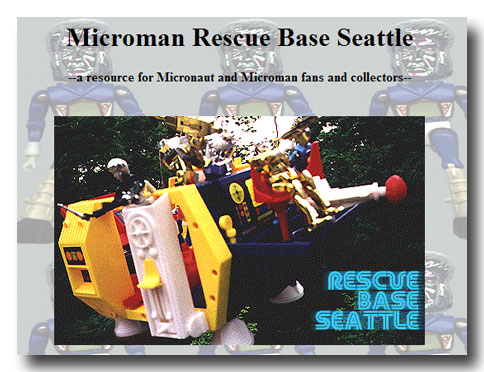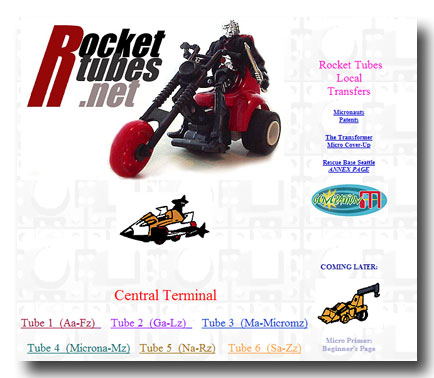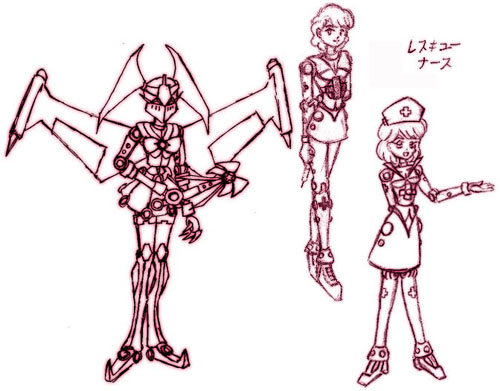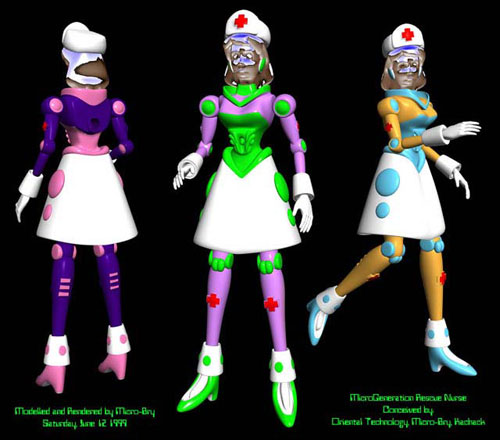Fanmode interview: Bryan Wilkinson (part 2)
Long-time Micronauts and Microman fan, Bryan “MicroBry” Wilkinson, is one of the select few who’ve made the transition from toy fan to toy designer. His website was one of the earliest to draw attention to Transformers’ (then) little-known origins, and he was given the opportunity to work on Palisades’ Micronauts revival in 2002. As Transformers celebrates its 25th. anniversary and Microman celebrates its 35th., we thought it only appropriate to ask him about Micronauts, Microman, Transformers, fandom, and making the transition from consumer to creator.
(Due to its length, the interview will be presented in several parts. Part one was published last week.)
When did you first get online?
My dad’s a software designer, so I had pretty early exposure to email, BBSes, and Usenet before the World Wide Web became big, so in a sense I was online from practically the beginning.
I first started using the Web itself around the mid-90’s, around the time I was working as an art technician on console and computer games. By this point it had been more than a few years since I’d really seen anything Micro-related. Few people my own age really remembered or cared about this stuff, and this was before Google and Wikipedia made it easy to naturally and casually look up every other thing that crossed your mind.
Around 1995, I thought to check the Usenet groups for any toy leads and found a couple of new Microman toys from parts of the line I’d not encountered before, so it rekindled my interest and curiosity.
I tried one of these new-fangled “web searches” and discovered Erik Larsen’s Micronauts Homepage (now Micronauts Outpost), which also linked to Tom Vigneau’s small Microman page (now gone), which in turn linked to the first Microman page from Japan, Arden’s Net (still around!) by Suzuki “Baron Arden” Gaku, and later a sadly defunct page called Build Base Tokyo.
Also along the way I found Ron Pringle’s Micropola page (which has come and gone over the years and also spawned a couple of impressive fanzines), Bwana Spoons’ print fanzine “My Friend the Micronaut”, and Sashida Minoru’s Oriental Technology, home of Microman Maniacs and MicroGeneration.
It does sadden me that fewer and fewer familiar “faces” are active with each passing year. I hope as we get older the community can consolidate efforts to preserve things for future generations of fans, but I know also that most fans that own their own sites tend to be (understandably) possessive and proud of their work, and without a proven beneficial model, are likely to be reluctant to allow their sites to be mirrored for the sake of preservation.

When did you create your own sites?
At first I put together a personal page in 1996. It had a bit about myself, a page for the anime I liked and projects I’d been involved with before, and a simple Microman page with a few low resolution scans and photos (good ol’ 56K modems, you know).
The Microman page got some interest and was the most fun to work on, so I later abandoned my personal page in favor of an online portfolio and a Microman page I called Rescue Base Seattle.
I mostly wanted at the time to share photos and what I knew about Transformers’ less known origins in the Microman line. I kept this page going and growing a couple of years and when Microman 1999 was announced, I did dedicated coverage for the release (which I believe helped inspire Paul Lorphanpaibul in turn as he soon started to cover Microman updates from Japan on his new Microman Forever site).
In the meantime, I found I had a lot of Japanese and Western links that not everyone knew about, so in 1998 I put together a site that would work as a nexus of links for Micro-related subjects. At first, it was a sub-page of Rescue Base Seattle, but I expanded it into Rockettubes.net.

However, as time went by, it became difficult for me to keep up and maintain the broken links and I was getting a bit down over a lot of the sites that closed after the Microman 1999-2000 line ended. I kind of left Rockettubes.net in limbo for a brief while.
After experimenting with a private blog, I realised that with a full-featured blog, I could achieve my original goals I had for both Rescue Base Seattle and Rockettubes.net—share topics of interest, pictures from my collection, reviews, and links to other pages in a more logical, readable format that required less personal maintenance and HTML editing. And thus my toy LiveJournal page was born in 2005.
Where did Micronauts fans congregate online during the early years?
We went through a lot of growing pains over the years. First, we met on a simple bulletin board on the Micronauts Homepage itself, which included sections for buying and swapping toys and such.
Later, we had a mailing list which had some management issues over time, so the membership quickly split off to two new mailing lists, one called Micropola and another named Microtalk. Microtalk and Micropola were ran very differently, which led to some disagreements between some members of each. In the end, membership became more centralized after Ray Miller formed Micropola Embassy Suite (later Micropolis Embassy) at Yahoo! Groups. I was a very active participant and shared as much info regarding Microman, the Japanese material and fansites as I could manage, and a couple of years later, Ray asked me to help moderate the group.
How did you get in touch with the Japanese Microman fan group MicroGeneration?
Initially I encountered MicroGeneration while exploring Sashida’s Oriental Technology pages in 1998 and was blown away by the new original Microman-inspired concepts and kits. With my limited Japanese knowledge, it was hard to figure out exactly what I was looking at, but I was able to see that in this period (after Romando’s releases and before Takara’s Microman revival) that there was an interest among Japanese fans in bringing Microman back to life, and that they were taking it into their own hands with these ideas and kits.
After sharing what I found with the mailing lists, I decided to try to reach out and contact these folks as best I could and ask about the kits and their availability. I had to rely on my limited Japanese knowledge and some so-so translation software I’d purchased (no web translation software for Japanese had come around just yet), so it was pretty awkward. This was the first time I tried contacting fans in the Japanese community, and I got a really warm response, as everyone was surprised to see foreign interest.
What I learned was the kits were made under Wonder Festival‘s unique one-day open license and as such were only available to attendees of the event, and as they were side projects made by fans in their free time, usually were limited to extremely low quantities per release (often, 5 to 10 pieces is considered a good run). It’s really just a chance to share ideas with other fans.
In what way were you involved with MicroGeneration?
Early on, there was some work on creating a female “Walroyear” (Acroyear equivalent) character that I contributed a crude sketch of an anime magical girl spin on, and as the topic turned to the possibility of a new female Rescue character, I suggested a “Rescue Nurse” and sent a couple of sketches that were really well received. One of the contributing artists refined the design and as I was teaching myself LightWave 3D at the time, I worked up a model in CG that was used for some of their postcard sets and later the packaging for the Rescue Nurse kits that were made.


Copyright © MicroBry & MicroGeneration.
My original concept was sculpted by a very talented Microman collector and kit/sculptor maker known as “The End” but never got cast as a kit to my knowledge, but a redesign, Rescue Nurse #2 was and the same folks also later did a kit of another figure based on one of my drawings.
The whole group of contributors really made me feel welcome and I was lucky enough to be able to take my one trip to Japan in 1999 during the time of the first Wonder Festival some of my work was shown at, and met many of the folks involved, some of whom had even generously saved extra kits for me and introduced me to folks from online fandom as well as designers from Takara.
Do Western and Japanese fandoms differ in the manner they approached things?
Overall, I think there’s a lot of similarities between fans. I do think that Japanese fans are better at getting together for events and such, facilitated by rail transportation. With a majority of fans living in and around Tokyo, it’s a lot more centralized. I think Japanese fans are more eager at large to create and share original and custom work than English-speaking fandom. On the other hand, I think English-speaking fans have made good use of the internet to communicate as a group and organize across more remote locales.
I think both fandoms share much of the same tastes for the same features of these toys that made them so appealing around the world, though. Most of us like our Micros with their chrome heads, cybernetic implants, clear body parts, and one-to-one scale, or at least some of these unifying factors. It’s true that Microman’s manga and anime adaptations have been pretty much polar opposites of the Micronauts comics, but there is some room for cross-appeal. I think both sets of fandom are curious about the stories they didn’t get to read growing up.
The internet has helped break some of the isolation and clear up some of the mysteries, but a lot still remains due to the language barrier. I’ve tried to learn more Japanese in the interim and hope to take formal classes again later, but it’s also my hope that the technological means to communicate across languages will continue to improve rapidly in the years to come. The Japanese are making really good progress with this in particular, as there has been a government incentive for improving translation technology. Translation software is no substitute for personally knowing some of the language and culture, but it’s a great aid all the same.
I’ve been working over the years in my free time on some fan translations of some of the manga and other materials from the series in the hope of helping improve understanding and appreciation of the original Microman series and its more recent incarnations. On the Micropolis Embassy, we’ve been gradually getting out translations of the little-seen but quite excellent 2005 Microman manga, and I’m collaborating on some scanlations of the original 1978 manga as well as translating the Microman backstory from Zero Zero Magazine.
It’s a lot of fun and hopefully we can get more people interested in Microman, whether they’re Micronauts fans, Transformers fans, manga readers, or just enjoy Japanese retro-sci-fi paraphernalia.
In part three of the interview, MicroBry talks about working on Palisades’ Micronauts revival in 2002.
